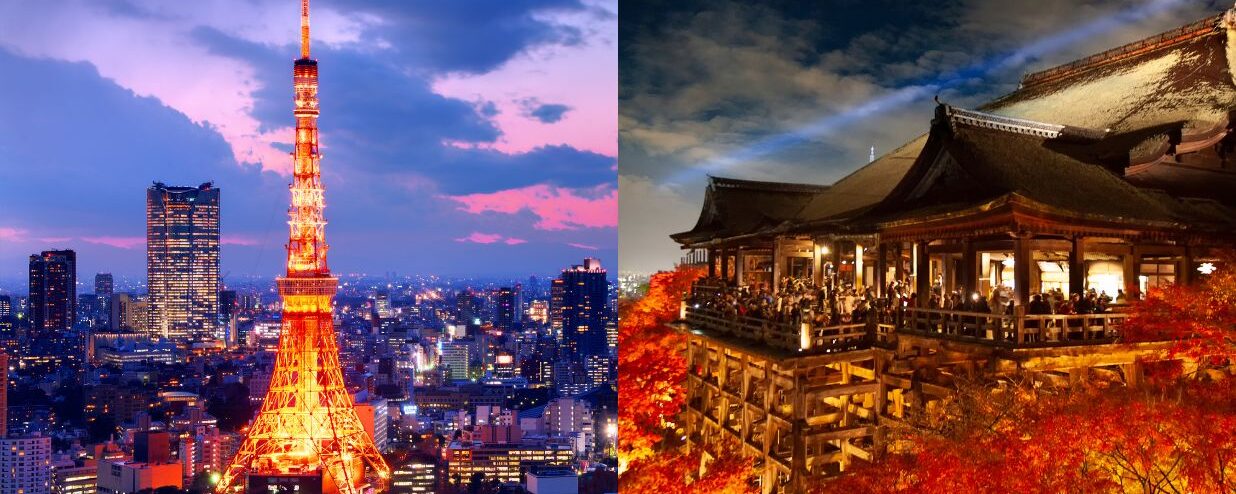Both cities are extremely popular outside of Japan and although they both use the same exact letters, these cities couldn’t be more different. Kyoto was the capital of Japan before that position was moved to Edo or present-day Tokyo. This is why their names are so similar since in Kanji, the 京 (Kyō) in 京都 (Kyoto) and 東京 (Tokyo) means capital. So, which one is worth spending more time in or living in? The historic capital rich in Japanese cultural heritage, or the modern capital at the center of global innovation?
What Is There To Do In Tokyo And Kyoto?
Tokyo: Modern Hub Of Technology And Experience
Entertainment and Events In Tokyo
As a giant global metropolis, the very fabric is international, modern, and yet traditional. It attracts many innovative entertainment exhibits such as Teamlab, a life-size moving Gundam, and a variety of tech and car shows. The city is also the video game and anime capital, with hubs like Akihabara featuring endless arcades to explore Japan’s newest games or even their classic titles.
You can still find many traditional venues and forms of entertainment in the bustling capital. For instance, there are a variety of Samurai experience tours or activities where you can make your own sword or practice slicing as the Samurai did. Tokyo is also home to the Meiji Jingu Shrine, Imperial Palace, and Senso-ji Temple, which are all wonderful cultural getaways from the neon-lit city.
If you want to catch your favorite artists, Tokyo is generally the 1st choice for global performers. Tokyo also hosts an international film festival, different cultural events, and has an annual Pride Parade called Tokyo Rainbow Pride.
Nightlife in Tokyo
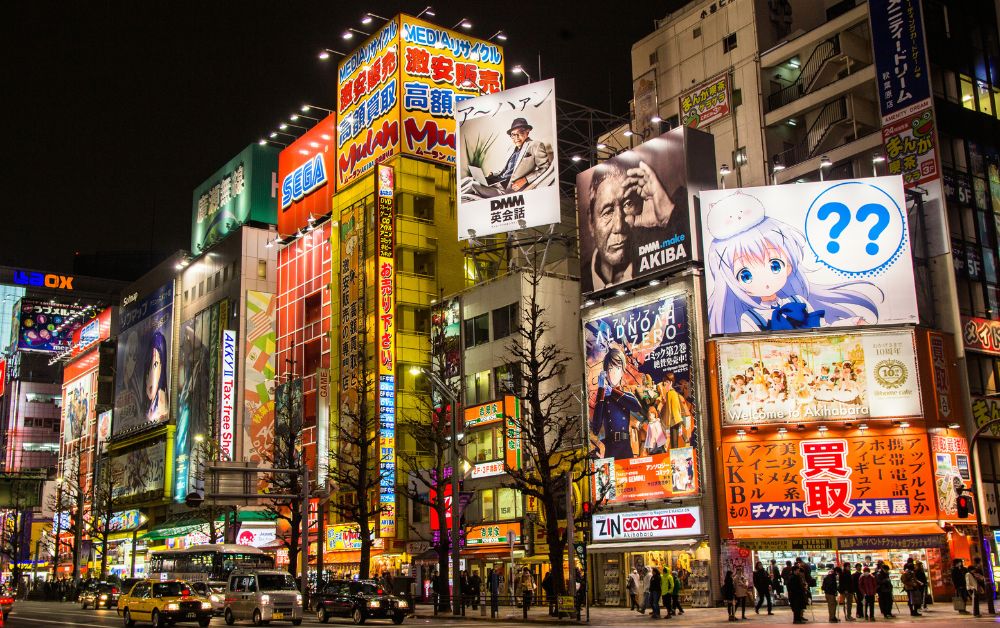
The capital at night turns into a kaleidoscope of flashy street signs, neon lights, and the mosaic of colors from bars and restaurants. You can find exciting nightlife, from karaoke to late-night bars in most neighborhoods or, at most, a train ride away. But to discuss living in Tokyo, it is impossible not to include some of the some of the world-famous hubs of nightlife entertainment:
- Akihabara: The mecca of Otaku culture teaming with all the Japanese pop culture you could desire. You could spend countless hours exploring the anime, manga, and video game shops as well as the retro arcades, themed cafes, and restaurants.
- Shinjuku: Home to the world’s busiest train station as well as the famous (maybe infamous) Kabukicho, the city is filled to the brim with bars, restaurants, movie theaters, adult entertainment and everything your heart could desire. You can also find Ni-chome here, which is the largest LGBTQ+ district in Japan.
- Shibuya: Likely the most popular location for its wide range of unique restaurants and bars. There are a billion things to do in this city that doesn’t sleep, such as popular clubs, Karaoke, and arcades.
- Roppongi: A very popular location for its nightlife, especially for foreigners, including international clubs, bars, and restaurants.
Kyoto: A Cultural Escape From Modernity
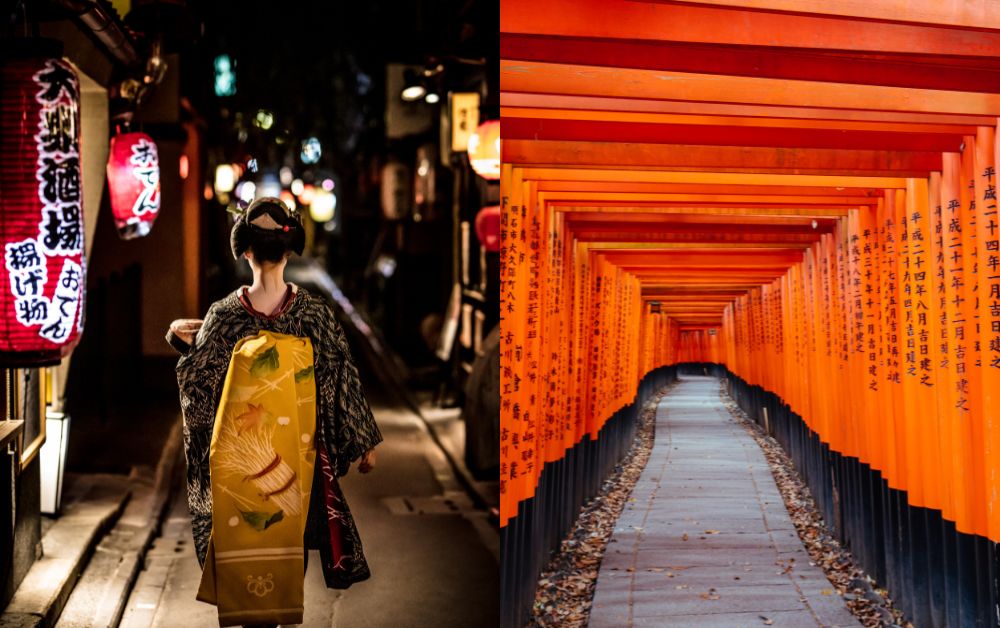
Cultural Experiences
Needless to say, Kyoto is globally recognized for its preservation of traditional Japanese culture. Being the historic capital of Japan, it played a pivotal role in developing many of the customs in Japanese society that have persisted to the present day. Throughout this cultural hub, you will find traditional machiya (町屋) houses, Geisha (芸者) performances, temples and shrines. Listed below are just a few districts to explore Japan’s traditions in Kyoto:
- Higashiyama (東山): One of the best-preserved districts in both Kyoto and Japan overall. Since the district sits between the Kyomizudera (清水寺) and Yasaka Shrine (八坂神社), you can enjoy a scenic route filled with small traditional shops, restaurants and cafes.
- Gion (祇園): Kyoto’s most famous Geisha (or Geiko) district. The area is scattered with traditional machiya or merchant houses and Ochaya (お茶屋) where you can experience Geisha performances. Perhaps, the most popular street, Hanami-Koji, immerses you into a past era of Japanese history. You can enjoy Kyoto’s Kaiseki Ryori at one of their machiya houses. Shirakawa is another popular scenic area full of traditional Ocha-ya overlooking the Kamogawa (鴨川) river.
- Shimogyo And Nakagyo: On the other side (west) of Kamogawa, are the Shimogyo and Nakagyo wards where you will find the famous Nishiki market, Nijo Castle, and Kyoto Imperial Palace.
- Arashiyama and Sagano: A beautiful and scenic area especially during the spring season when the Sakura trees are in full bloom. These districts have been frequented for their awe-inspiring nature since the Heian period (Around 794 A.D.). Beyond the picture-esque bamboo grove, you can find a plethora of temples, well-preserved historic streets, boat tours, and much more.
- Fushimi Inari Shrine: One of the most recognized sights in not only Kyoto but Japan as well. It is home to the world-famous rows of tori-gates, shown in the image above.
Nightlife in Kyoto
Possibly, one aspect of living or traveling in Kyoto that does not receive the attention it deserves is the nightlife. When the sun falls, and the moon rises, Kyoto transforms into a glowing cityscape that perfectly balances the modern with the traditional. Although not comprehensive, below is a list of spots and activities to explore in Kyoto after dark:
- Pontocho: An ambient alleyway embodying the best Kyoto has to offer at night. The street is overflowing with chic bars, traditional tea houses, and a diverse range of restaurants. You can find modern Japanese and foreign cuisine as well as more traditional offerings of Kyoto.
- Gion: The Gion district mentioned earlier makes for an entertaining visit in the evening and night. You can catch evening tea ceremonies or book a dinner with a Geisha performance. However, be aware that a private Geisha performance supper will likely break the bank if you’re on a budget.
- Kiyamachi Street: Located along the river running parallel to bustling nightlife, Kiyamachi offers an eclectic collection of bars, restaurants, and clubs all with a wonderful view of the night sky reflecting off the river current.
- Live Music Venues: Beyond the traditional performances of Geisha with a shamisen (a Japanese banjo-like instrument), Kyoto is home to a vibrant live music scene. You can find a range of genres, from jazz, rock, to hip-hop. With bars like Zac Baran or Takutaku hosting live performances for over 50 years, the cultural capital of Japan is truly a live music hotspot. This is a testament to Kyoto’s complex identity as a city that balances tradition and progress.
Which Has Better Food: Kyoto vs Tokyo?
Tokyo and Kyoto attract millions of tourists every year resulting in both of them delivering an eclectic collection of international food as well as boasting their own regional delicacies. Kyoto is considered to be more of a specialist in terms of its Japanese food offerings.
Food in Tokyo
Being the largest and most global city in the country, the capital brings together the best from different regions in Japan and even the world. It likely has the highest number of mouth-watering options you can find. Below, I provided just a few recommendations.
Sushi (寿司)
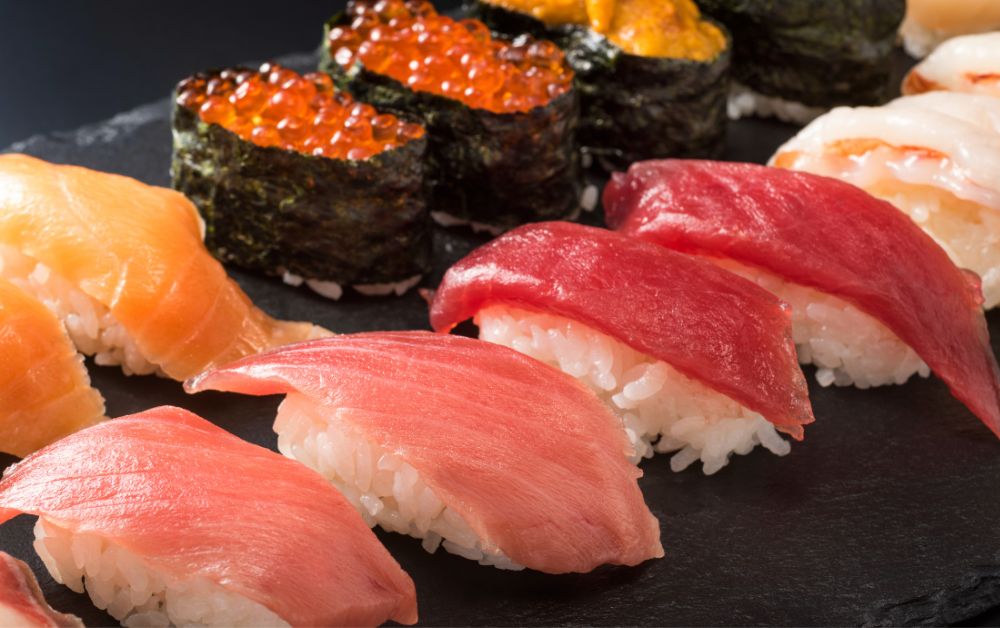
Tokyo is globally sought after for its renowned sushi eateries. Sushi as we know it today may have originated in the Yatai stalls of former Edo or modern-day Tokyo. Although the top-rated restaurants are known for breaking the bank, high-quality sushi can be found on every budget.
Lower-budget Sushi:
Mid-range sushi:
The Finest Sushi:
Tonkatsu (豚カツ)
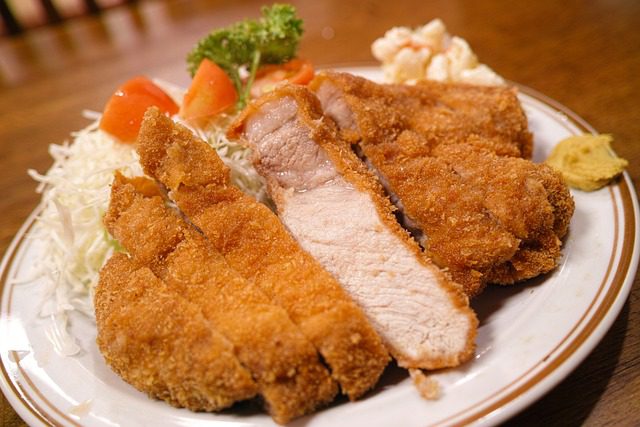
Tonakatsu can likely be found all over Japan but Tokyo possibly has some of the best. One case in point, Tonkatsu.jp captures the spirit of Tokyo by allowing customers to choose between different cuts and which region the pork is sourced from.
Gyukatsu (牛カツ)
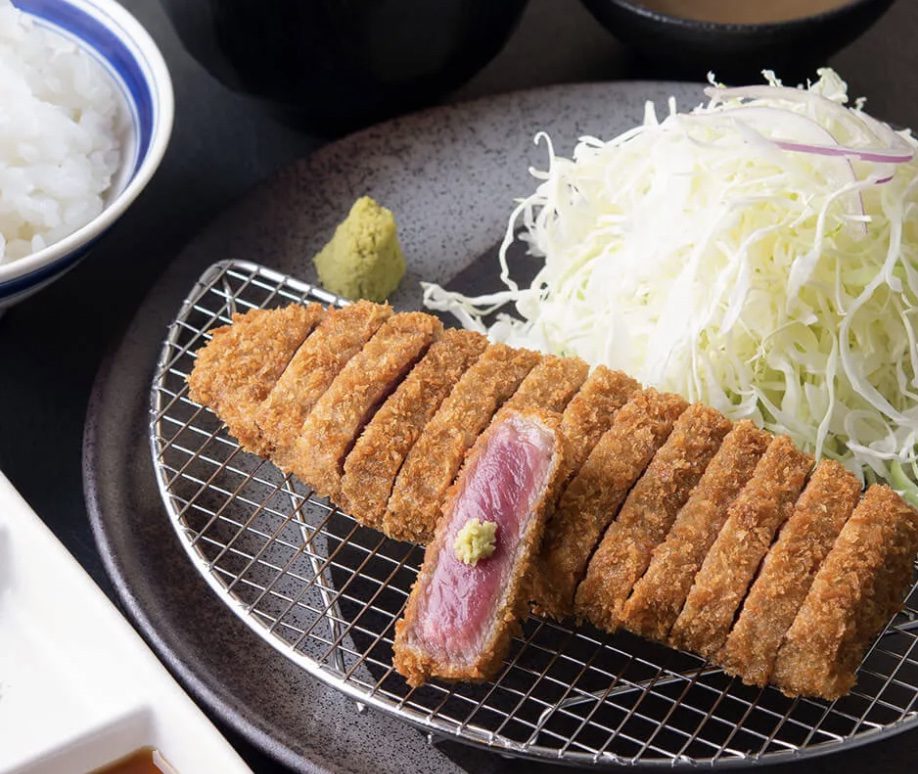
Image from Katsugyu
Not to be confused with tonkatsu, it’s a fried cutlet using beef instead of pork and is said to be a Tokyo original. They are often made with wagyu beef which is world renowned for its soft and tender texture. One shop rapidly gaining popularity, Gyukatsu Iroha, for its juicy yet affordable gyukatsu attracting long lines every day.
Monjayaki (もんじゃ焼き)
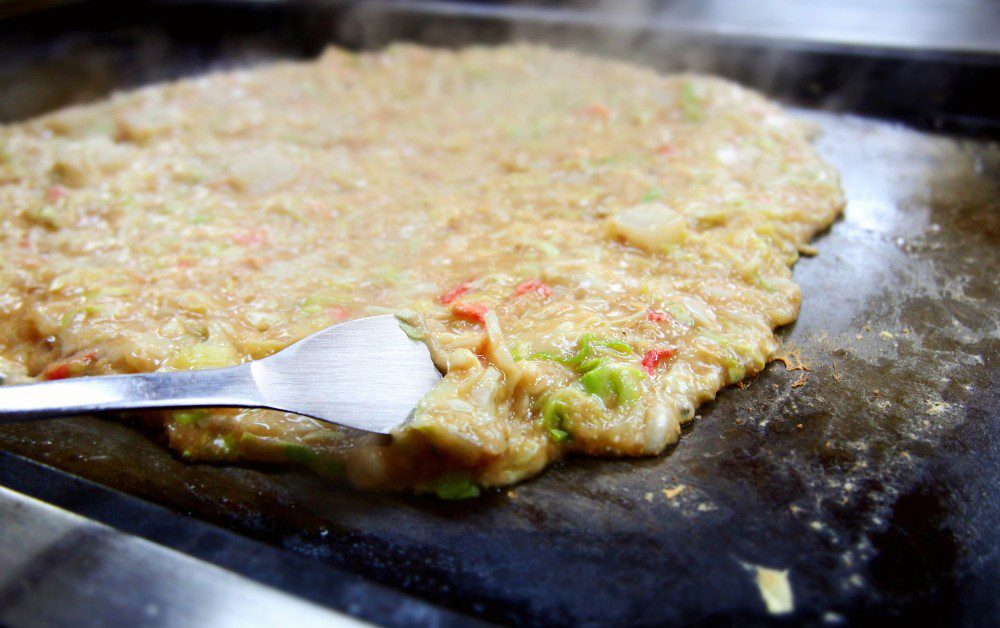
Monjayaki can be described as Tokyo’s take on the Osaka specialty, Okonomiyaki. The ingredients are very similar, except the batter is much more liquid, making the final product much thinner and needs to be scooped up rather than cut into pieces like Okonomiyaki. In Tokyo, restaurants often serve both but there is an area that specializes in Monjayaki called the Tsukishima Monja Street.
Shin-Okubo Korea Town
Shin-Okubo, home to the Korean town of Tokyo, overflows with Korean cosmetics, clothing stores, supermarkets and restaurants. Due to the area organically attracting other foreign residents in Tokyo, you can find clusters of international cuisine generally from South Asian and Southeast Asian regions.
Kyoto Cuisine
Kyoto embodies a wide range of cuisines from modern international foods to regional cuisine utilizing fresh local ingredients.
Kaiseki Ryori (会席料理)
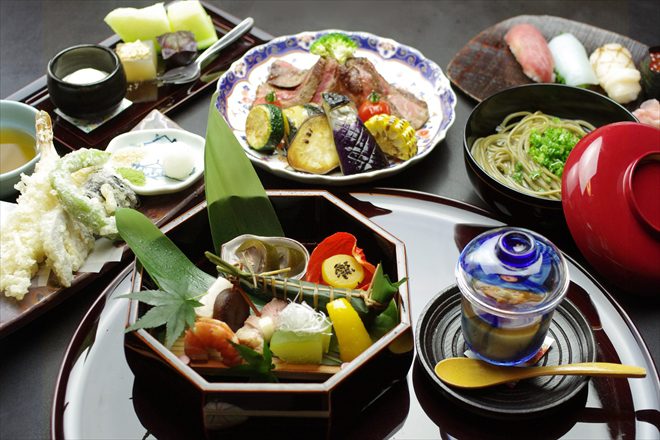
Image from Gion Hanasaki
Since Kyoto was a central area in history, the city’s distinct Kaiseki Ryori became very famous and developed from the noble figures living in the former capital. Kaiseki is a traditional multi-course dinner known for its dedication to artistic presentation and usage of very local ingredients. Everything from the flavor to the color is meticulously prepared and chosen in order to maintain the most delicate balance. The word 会席(Kaiseki) can translate to formal occasion while 料理(ryori) means cooking which really captures the meal’s sophistication. Although the fine dining course is usually expensive, it is very much worth the experience. However, it is often included during stays at a Ryokan making their price well worth it.
Obanzai Ryori
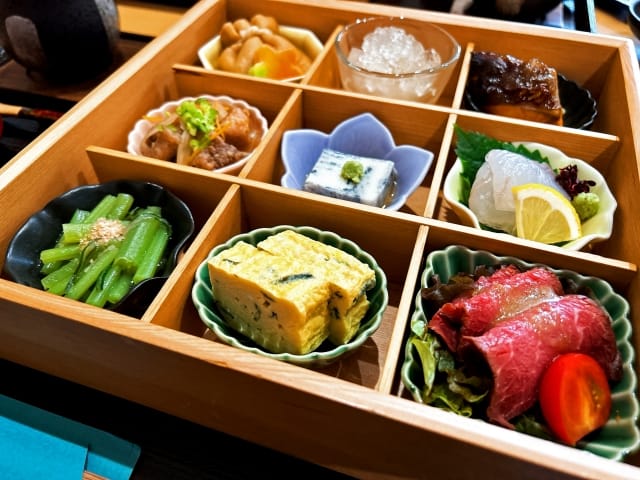
Image from Magical Trip
Obanzai Ryori is the everyday household cooking of Kyoto, consisting of multiple small dishes. It is characterized by its simple ingredients, all (or mostly) sourced from Kyoto prefecture. The style of cooking embraces the philosophy of respecting each ingredient and avoiding waste. The meals are embodied by the usage of foods that are often thrown away. Being a quintessential cuisine of Kyoto, Obanzai is available all across the historic capital and often at very affordable prices.
Shojin Ryori (精進料理)
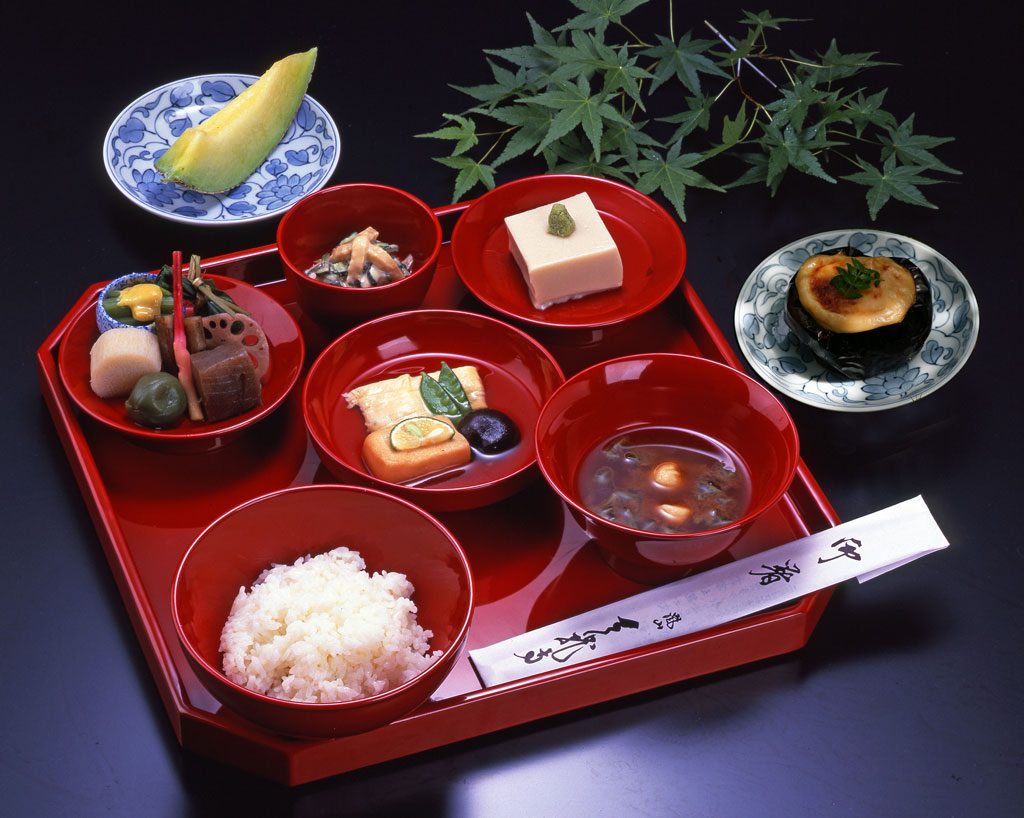
Image from Tenryuji Temple
Originating from the countless Buddhist temples that sprung up in Kyoto over 1000 years ago, Shojin Ryori is a form of cooking that does not use any meat, fish, nor any overpowering flavors. It is characterized by its simplicity and use of vegetables and tofu. Don’t be fooled by the lack of spice or boldness, Shojin Ryori consists of a delightful yet minimal flavor palette letting the nuances of the freshest local ingredients take center stage.
Yudofu (湯豆腐)
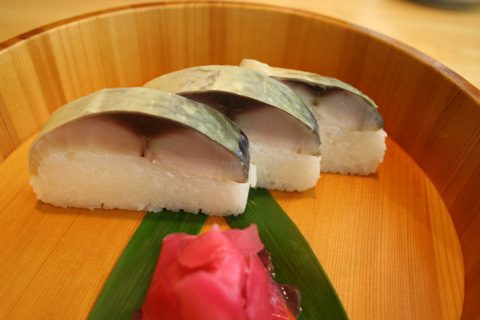
Image from Kyoto Foodie
Due to Kyoto’s geographic location, fresh fish was difficult to transport without spoiling, leading to the creation of Kyoto’s style of sushi called Kyozushi. They consist of fish cured with salt or vinegar which was historically used as natural preservatives. One of the most notable Kyozushi is Saba-zushi or sushi made with mackerel.
Japanese In Kyoto vs Tokyo
Dialects
Tokyo’s Dialect or Kanto-ben (関東弁)
Due to Tokyo’s influence on the nation, Kanto-ben (Tokyo dialect) is considered to be standard Japanese. Whenever you learn Japanese, you are most likely learning Kanto-ben. The dialect is characterized by flatter pitches and intonations which make it simpler to understand and easier to standardize. It is also the main language used and studied in Japan’s public school system.
Kyoto Dialect or Kyoto-ben (京都弁)
Kyoto-ben, also known as Kyoto-kotoba (京都言葉), is the dialect spoken in Kyoto prefecture and has roots dating back to the Heian period (794 A.D.). Due to Kyoto’s history as the capital and cultural hub of the nation, the dialect is softer and very polite, reflecting the grace necessary to navigate the culture of nobility.
Kyoto Dialect VS Tokyo Dialect: What’s The Difference?
While Kanto-ben is considered to be the most proper in the modern day, Kyoto-kotoba is still seen as very polite and even sophisticated. Due to Kyoto-ben’s softer intonations, one of the most notable differences is the verb endings. In Kyoto they use osu (おす) or dosu (どす) over the standard desu (です). For example, to say “this is pretty” in Kyoto-ben is きれいおす (kirei osu) whereas in Tokyo, it would be きれいです (kireidesu). There are many other instances of Kyoto-kotoba using softer verb forms or sentence endings, but even certain vocabulary strays from Kanto-ben. Although nowhere close to comprehensive, below is a short list of common words in Kyoto-ben along with their Kanto-ben counterparts:
| Kanto-ben (Tokyo Dialect) | Kyoto-ben | English |
| ありがとう (arigatou) | おおきに (ookini) | Thank you |
| ごめん (gomen) | かんにん (kanin) | Sorry |
| いくら (ikura) | なんぼ (nanbo) | How much (cost) |
| 似てる (niteru) | 似おてる (nioteru) | Similar or resemble |
| いらっしゃいませ (irasshaimase) | おいでやす (oideyasu) | Welcome |
Studying Japanese in Kyoto vs Tokyo
Living And Learning Japanese In Tokyo
Tokyo is defined by its dynamism and availability of everything imaginable, so, the capital will have the most options in learning opportunities and resources for studying Japanese. Learning Japanese is low-hanging fruit with options like student exchange programs, a plethora of language schools, and the availability of language exchanges or meet-ups. There are also communities and groups that allow interaction with both natives and foreigners who can help with studying Japanese.
Coto Academy is a language school in both Yokohama and Tokyo that provides lessons for those studying Japanese at any level, from beginner to advanced. The schools not only provide classes but a supportive community of fellow learners and native Japanese teachers to help guide you through your language learning journey.
We hold many events to meet new friends and practice Japanese conversation! We also offer shorter term cultural experiences to both learn Japanese and immerse in Japanese culture during your visit. To find a class right for you, take a look through our courses here.
Living And Learning Japanese In Kyoto
While Tokyo might have more options, Kyoto may allow for deeper immersion. If you decide to live in Kyoto, you likely won’t be sticking around the most touristy areas. As a result, there won’t be as many opportunities to speak English as Kyoto is not as international as Tokyo and there are far fewer English speakers.
Although there are fewer schools than in Tokyo, the language schools in Kyoto tend to integrate cultural immersion into the lessons. This allows students to learn about traditional Japanese culture along with the Japanese language. While there may be fewer foreign social events, the quieter, more serene atmosphere of temples and nature might be a preferable studying experience.
Kyoto vs Tokyo: Cost Of Living
Salary
The average salary in Tokyo is 574,000 JPY (4,229 USD), and in Kyoto is 537,000 JPY (USD). Both are higher than the average national salary, however, in comparison to living expenses, Kyoto is remarkably lower, allowing for more disposable income. Keep in mind that the average salary is subject to outliers so the average salary will be different for someone only having 2 years of experience. In general, a common starting salary in Tokyo is around ¥250,000, while in Kyoto, it could very easily be lower.
Rent
Average rent costs in Tokyo are vastly higher compared to Kyoto. Tokyo rent is almost 2 times more expensive. Even in the city centers found in the chart below, Kyoto is much more affordable (prices are for single apartments 1K/1DK):
| Most Expensive Wards Tokyo (1K/1DK) | Most Expensive Wards Kyoto (1K/1DK) |
| Minato ¥111,000 | Shimogyo ¥59,000 |
| Chiyoda ¥105,000 | Minami ¥59,000 |
| Chuo ¥100,000 | Nakagyo ¥56,000 |
| Shibuya ¥104,000 | Kamigyo ¥54,000 |
| Shinjuku ¥98,000 | Sakyo (most popular ward) ¥51,000 |
Living Expenses
Depending on the source, Tokyo is somewhere around 19% to 30% more expensive than Kyoto. This is mostly due to rent in Kyoto being much more affordable while utilities and groceries are slightly cheaper than in Tokyo. Transportation might be more expensive in Kyoto, however, depending on where you live, it is possible to get around with a bike alone. Tokyo being more spread apart and affordable housing further from the business centers makes biking alone an unlikely option for daily commutes.
Kyoto vs Tokyo For Expats
Tokyo, by far, employs the most foreign workers in Japan, but Kyoto offers unique opportunities for foreigners.
Which has more employment available for foreigners?
Tokyo, as the capital and business center of Japan, employs the most foreign workers by far. It hires almost 20 times more foreigners than Kyoto. However, Kyoto has higher concentrations of foreign workers in certain sectors especially in manufacturing and somewhat in accommodation/food services and education. This shows that Kyoto is fertile ground for roles in certain sectors compared to Tokyo being spread out evenly with the exception of very low employment in areas like medicine and construction. Of course, the types of roles you get will largely depend on your background and what is best for your career path. Below is a breakdown of foreign employment in both cities:
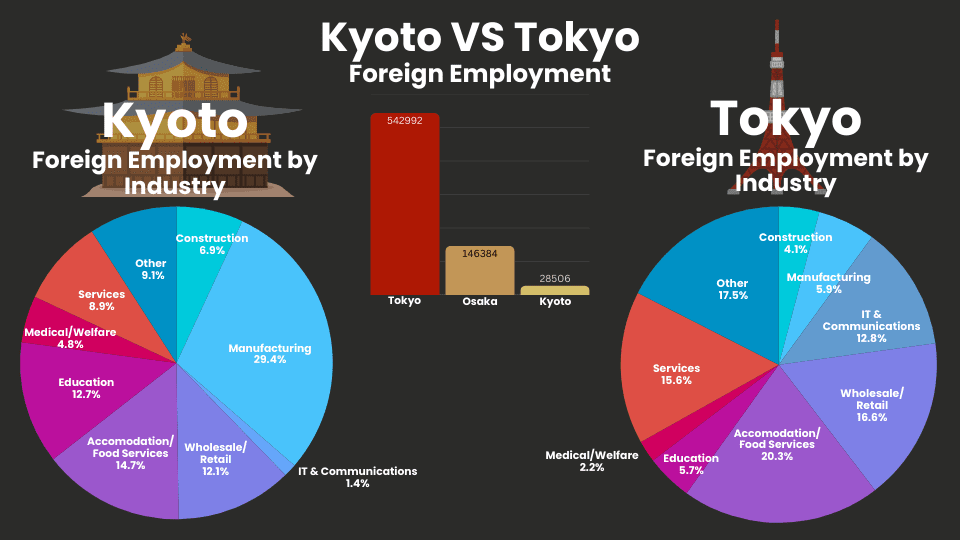
Traveling To Tokyo
Tokyo has the most direct flights from any country or any city domestically making the Capital the most common entry point into Japan.
Airports In Tokyo
Haneda Airport
The Haneda Airport is located in central Tokyo (Ota city) and is busier compared to Narita Airport, the other airport closest to Tokyo. Haneda primarily focuses on domestic flights, however, after opening a fully dedicated international terminal, it is rapidly increasing international flight operations. It has many direct flights to major cities in North America, Europe, and Asia.
Between the 2 airports in/near Tokyo, Haneda is the more convenient option with buses that go directly to the majority of neighborhoods in Tokyo. It is also located much closer to the city center, being around 30 mins to 1 hour from major hubs such as Shibuya, Shinjuku, and Tokyo station via train or bus.
Narita Airport
Narita Airport is still Japan’s primary international gateway and operates the most long-haul and intercontinental flights. The airports has more airlines covering different parts of the world such as the Middle East, Africa, Southeast Asia and South Asia. To travel to and from these areas, you would likely need to fly into Narita.
Narita is much further from the city center, being over an hour from Tokyo station and closer to 2 hours from Shibuya and Shinjuku via train. You can also take a bus from different areas in Tokyo which is more comfortable when you have a lot of luggage. However, buses do not go to as many neighborhoods around Tokyo compared to Haneda.
Traveling To Kyoto
Airports Closest To Kyoto
Osaka International Airport (Itami Airport)
Kyoto does not have its own airport, but the closest is the Osaka International Itami Airport (ITM) which is about 38 km away. The easiest way to Kyoto from the airport is the Airport Limousine Bus which is also pretty affordable at ¥1340.
Keep in mind that this airport mostly handles domestic flights so you would most likely need to transfer from an international airport such as Narita or Kansai Airport.
Cost And Commute To/From Itami Airport
| Airport Limousine Bus | Monorail and Train | |
| Cost | ¥1340 | ¥680 |
| Duration | 50 minutes | 60 minutes~ |
| Reservation Required | No | No |
| Transfers | None, Direct to Kyoto Station | 2 transfers: Monorail to JR Railway or Hankyu Railway |
Kansai International Airport
Kansai International Airport, or Kanku, is the primary operator of international flights going into the Greater Osaka area. It is the closest international airport to Osaka, Kyoto, and Kobe. The airport makes it possible to visit Kyoto without ever needing to transfer from Tokyo. However, international flights may not be as frequent or cheap as those to Tokyo.
Getting to Kyoto From Tokyo
Flying to Kyoto from Tokyo is the quickest and, surprisingly, one of the cheapest routes. It takes only 2-3 hrs and usually costs around ¥5,000 ($32~) to fly to Osaka International Airport. From there you can take a bus to Kyoto, which takes about 50 minutes, as described above.
Alternatively, you can also take a night bus to Kyoto. Generally, they cost around ¥5,000 and take around 9 hrs. Since it is overnight, theoretically, the night bus would align with your sleeping schedule, however, don’t expect the comfort of a bed nor the same quality of sleep. Depending on the season, it could be the cheaper option compared to flying, but most of the time, the price between the two doesn’t vary much.
Getting Around Kyoto Or Tokyo
Tokyo Transportation
Tokyo has one of the most efficient transportation systems in the world, as it successfully commutes the busiest stations in the world every day. The JR lines and Tokyo metro will take to just about every station in every local district. Buses are also widely available and can take you closer to your final destination. Overall, you can get around just about all of Tokyo via train alone.
Kyoto Transportation
Kyoto is much smaller and compact making buses or bikes a suitable option for getting around the city. Trains do run through central Kyoto but stations are not as widespread as they are in Tokyo. As a result, they are not used as frequently for getting around local neighborhoods, but trains can still be a very convenient option for getting somewhere farther in the city or going somewhere nearb,y such as Osaka.
Is Kyoto Or Tokyo Better For Foreigners?
Both iconic metropolises are worth a visit if you can find the time and the budget during your trip to Japan. However, if you have to choose one especially to live in, there are a few things to consider. Tokyo is going to have vastly more resources, a wider variety of opportunities, and more foreign-friendly events. The current capital also has English and other foreign language support available throughout. Just in sheer things to do, Tokyo is the best place in Japan to find specific interests and niches. However, Tokyo can be a high-stress environment that’s overcrowded and seems devoid of peace and nature.
Kyoto, outside of all the high-volume tourist locations, is quieter, more serene, and ideal for anyone who really wants to immerse in traditional Japanese culture. There is an abundance of streets and temples that are extremely well preserved, creating a truly Japanese atmosphere. However, there is possibly a lot less foreign language support which can be a benefit for immersion while inconvenient for those who need it. Kyoto is perfect for nature lovers and those who enjoy taking in scenic views. The historic capital still offers an interesting nightlife where the modern and traditional live in harmony.
So which do you think is right for you? If you plan on visiting Japan, why not learn Japanese while you are here! We offer both online classes as well as in person programs. Whether you decide to live here or visit, we have long term classes or cultural experience courses for those who want to immerse in Japanese culture while learning Japanese.
FAQ
Is Kyoto or Tokyo better for students? What is the best city in Japan for students?
Tokyo has the most programs and universities but Kyoto allows for unique learning opportunities for Japanese language, history, and culture due the city’s long history.
Is 2 days in Kyoto enough?
Kyoto is not a huge city and you can make an itinerary that allows you to hit most of Kyoto’s iconic temples and attractions in just 2 days. Key areas such as Gion, Higashiyama, Shimogyo And Nakagyo are all within walking distance from each other.
Is Kyoto or Tokyo better for food?
Tokyo has the most variety of food both Japanese and international. However, Kyoto is known for its high quality local ingredients allowing for wonderful and fresh regional cuisines. Banzai ryori, for example, is a delightful homestyle form of cooking using local ingredients and made up of side dishes.
Which city has better public transportation?
Tokyo overall has more efficient transportation due to its vast train network system. Kyoto does have an effective train system that is mostly used for going farther distances across the city or out of the city. Kyoto is much less spread out than Tokyo so it is possible to get around using a bike.
Is Kyoto calmer than Tokyo?
Kyoto’s most popular tourist attractions and spots might be more crowded than the average area in Tokyo. However, if you avoid the most touristy areas, you will find Kyoto is quieter and surrounded by more nature and serene Japanese architecture.
Which city has more job opportunities for foreigners?
Tokyo has far more job opportunities, but demand for foreign workers is growing in Kyoto. Kyoto’s tourism industry may also bring unique opportunities for expats.
